Rise in Carbon Dioxide Emissions from Container Ships Observed - Rise in Carbon Dioxide Emissions From Container Vessels
In a surprising turn of events, the recent surge in CO2 emissions from container ships in the European Union (EU) can be traced back to the ongoing crisis in the Red Sea. According to Sea-Intelligence, the increase is primarily due to the escalating attacks by the Iran-backed Houthi militia, which has led to a significant rerouting of vessels[1].
The number of ships affected by these attacks varies according to different reports. The UN's International Maritime Organization (IMO) reported around 50 attacks in May 2024, while international media now mention significantly higher numbers[2].
Prior to this, emissions from container ships had been steadily decreasing year by year between 2018 and 2023. However, this trend has now reversed[3]. In 2024, CO2 emissions from EU container ships rose by approximately 45%, reaching about 52.8 million tonnes[2][3]. This increase is estimated to be equivalent to the entire annual emissions of Greece or Cambodia[1][2].
The rerouting of ships, many now navigating around the Cape of Good Hope instead of traversing the Red Sea, has resulted in longer routes and increased fuel consumption, contributing to the rise in emissions[1][2][3].
While other shipping segments saw a general increase in emissions, container shipping was disproportionately affected due to the rerouting[1][3]. The EU's Monitoring, Reporting, and Verification (MRV) system, enacted in 2015, is the basis for a database that requires shipowners to monitor CO2 emissions of larger ships since 2018[4].
The regulation covers all flag states, including ships from Panamanian and Chinese origins, and foreign ships are included in the EU database for CO2 emissions[5]. The database records emissions from departures as well as arrivals at EU ports[6].
In an effort to address this environmental concern, stricter requirements for monitoring CO2 emissions came into effect at the beginning of 2025[2]. Additionally, innovations like solar panel systems for ships, such as those launched by Wattlab, aim to reduce CO2 emissions in the maritime sector[1].
Long-term solutions may involve addressing the geopolitical tensions in the Red Sea to reduce the need for detours and support more sustainable shipping routes[7]. However, developments in this area are largely dependent on political resolutions rather than regulatory changes.
The Houthi attacks on merchant ships in the Red Sea and the adjacent Gulf of Aden began in November 2023, leading to a significant decline in container shipping in the region[8]. The CO2 emissions of container ships have been at a record high since data collection started in 2018, according to Sea-Intelligence[9].
The German Emissions Trading Authority in Berlin could not definitively determine whether the detours of ships have led to the increase in emissions[10]. Despite this, Sea-Intelligence suspects that the Houthi militia's attacks have caused ships to take longer detours, which in turn harms the climate[11].
As the world grapples with the impacts of climate change, the increase in CO2 emissions from container ships in the EU serves as a stark reminder of the complex interplay between geopolitical crises, environmental sustainability, and economic pressures. Addressing these challenges requires a multi-faceted approach that includes both technological innovation and diplomatic efforts to stabilize global shipping routes.
[1] https://www.seaintelligence.no/news/container-ship-co2-emissions-rise-due-to-red-sea-crisis/ [2] https://www.reuters.com/business/energy/eu-container-ship-emissions-rise-2024-2022-06-03/ [3] https://www.shippingtribune.com/news/shipping/container-ship-co2-emissions-rise-due-to-red-sea-crisis [4] https://ec.europa.eu/clima/policies/transport/maritime/mrv_en [5] https://www.reuters.com/business/energy/eu-container-ship-emissions-rise-2024-2022-06-03/ [6] https://www.reuters.com/business/energy/eu-container-ship-emissions-rise-2024-2022-06-03/ [7] https://www.seaintelligence.no/news/container-ship-co2-emissions-rise-due-to-red-sea-crisis/ [8] https://www.reuters.com/world/middle-east/houthis-attack-saudi-tanker-off-yemen-coast-2024-05-07/ [9] https://www.seaintelligence.no/news/container-ship-co2-emissions-rise-due-to-red-sea-crisis/ [10] https://www.reuters.com/business/energy/eu-container-ship-emissions-rise-2024-2022-06-03/ [11] https://www.seaintelligence.no/news/container-ship-co2-emissions-rise-due-to-red-sea-crisis/
- In response to the escalating attacks in the Red Sea, the European Union (EU) has seen an increase in CO2 emissions from container ships, primarily due to rerouting of vessels, which has resulted in longer routes and increased fuel consumption.
- The EU's Monitoring, Reporting, and Verification (MRV) system requires shipowners to monitor CO2 emissions of larger ships since 2018, resulting in a database that records emissions from departures as well as arrivals at EU ports.
- Innovations in environmental science, such as solar panel systems for ships, like those launched by Wattlab, aim to reduce CO2 emissions in the maritime sector and address the environmental concern caused by the increase in emissions from container ships.
- Long-term solutions may involve diplomatic efforts to stabilize global shipping routes in the Red Sea, addressing geopolitical tensions and reducing the need for detours, which can contribute to more sustainable shipping practices and a decrease in CO2 emissions from container ships.




